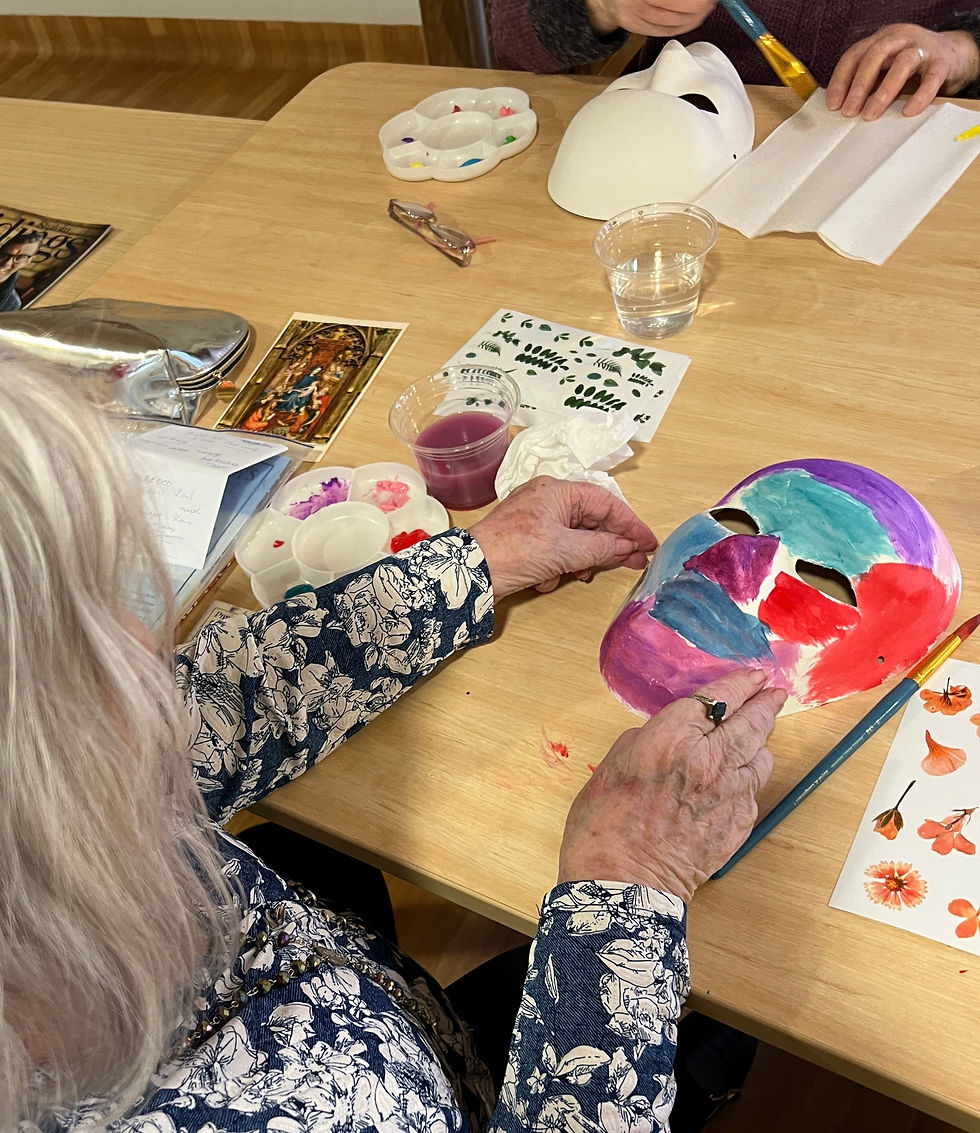5 Art Activities for Aged Care Beyond Colouring-In
- Engaged Art Therapy
- May 29, 2023
- 4 min read
Don’t get me wrong, I am not against colouring-in. I think it’s an excellent introduction to engaging in art activities especially for those who might not feel confident in participating in anything remotely artistic. As a former Lifestyle Coordinator, I understand how much work is involved in facilitating art activities in aged care groups. It takes a lot of preparation that you often do not have enough time for. When you have a group of 5-8 residents all at once and you are on your own, sometimes colouring-in can be the most feasible option to do. And that’s fine too – any way that residents can engage with art is better than having no art engagement at all.
If you have the capacity to facilitate art activities in aged care homes that go beyond colouring-in, here are some suggestions. As an art therapist in aged care, I have tried and tested these projects with groups and the feedback has been overwhelmingly positive.
Ideas for Art Activities for Aged Care
1) Leaf printing
Nature is always a good source of inspiration. A leaf print invites us to tune in to the beauty of nature and to notice the intricacies of the leaf veins. Starting with a circle, invite the residents to create a pattern using different leaves. The circle provides a starting point – it can be intimidating to start with a blank paper. Also encourage them to think “outside of the circle” and treat it as a suggestion only. They may have their own pattern in mind, much like this resident who chose to fill the entire paper with leaves.
Materials: Leaves of different sizes and textures, paper, paint, brushes

2) Mask painting
Mask making is quite a universal art therapy directive that can be used in many ways. In a recent art therapy group with aged care residents, there were mixed reactions upon seeing the blank mask for the first time. Some residents found it strange at first. This is not something you see everyday after all. Once they started painting their masks, there was a sense of playfulness that emerged. Creative play is essential at any age.
Painting masks can offer a more dynamic way of art-making by providing a 3D surface to work on. You can also offer cut out images to put on the mask if the resident prefers to use these. Paint, glitter, gem stickers are all great options to decorate the mask in a way that creates a personal meaning for them. Art therapy activities in aged care are not only fun and engaging, they are also meaningful.
Materials: Mask, glue, pre-cut images, paint, other craft materials such as glitter, stickers, textured paper etc.

3) Stencils
Stencil printing is a great structured activity that produces a visually satisfying outcome. I like to layer stencils in different colours and have the last layer as the main image. It’s always a nice surprise for residents to see the pattern as it is revealed. Each resident can make their own original pattern by choosing which stencil to use and what colours to use. There are a variety of stencils available out there. In my experience, using a sponge stamp brush to lay down paint on the stencil works best.
For older people living with dementia, starting with a blank piece of paper can be daunting. Structured art activities that have clear and simple steps can be very helpful to guide them in their creative process.
Materials: Stencils, paper, stencil brush or sponge stamp

4) Stained glass effect
While the actual stained glass art can be challenging to facilitate in an aged care setting, you can certainly modify the process to make it suitable for residents. We need to be adaptable when we think about creative ways to engage the residents and provide accessible art experiences. In this stained glass effect project, residents use a gel-like paint made out of a mixture of clear glue and food colouring to paint on a glass surface. Glass surfaces include vases, upcycled jars, candle holders etc. I’ve also used it on a clear plastic clip board with great success as you can see from the red flower below. The black outline is drawn with a mixture of pva glue and black acrylic paint squeezed out from a glue bottle. This requires a lot of preparation time but the outcome is remarkable.
Materials: Clear glue, food dye, palette, brush, pre-drawn pattern on the surface - glass or clear plastic

Optional: add glitter

5) Painting with cotton buds
Every time I’ve done this with residents, they are always amused by the fact that we are using an uncommon material to make art. Who would have thought that cotton buds can be used for art-making? Providing novel experiences such as this one makes art time more engaging. And it creates a beautiful print that can be achieved in simple steps. You can prepare a bunch of cotton buds tied together with a rubber band ahead of time. There are several video tutorials online that use cotton buds for painting if you want to get more ideas on what to make, like this one.
Materials: cotton buds, paint, canvas or paper, paint brush
These art activities for aged care do require a bit more preparation time than if you were to do a colouring-in session. If you can make time, I encourage you to try one of these and tailor them to your residents’ needs.
Offering new opportunities for creative expression can improve resident engagement that will keep them coming back to your groups. It also expands their creativity as they experience novel art activities. In Engaged Art Therapy, we value new ideas for residents to express their creativity. To learn more about our services for aged care, contact us here.

Comments